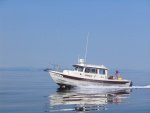Over the weekend got to use my Honda 5hp kicker motor on a 22 Cruiser fully loaded with lots of gear.
Long story short - was anchored at Santa Cruz Island,Ca west of Prionsers Anchorage. We where Diving having a great time, got back on board and attempted to start the main motor 90HP Honda and it was dead.......no electrical power. Burned a few hrs debugging the problem but was not able to get it running at this point decieded to move to a more safe anchorage incase the weather turned.
Ocean was calm but things change quickly at the islands.... Fired up my 5HP kicker motor, was able to the get the fully load C-Dory up to a steady 6.5kts with the main motor down for steering. Had to travel ~2 miles to my favorite anchorage on Santa Cruz Island called Prisoners Cove / Anchorage.
Once at a more safe anchorage location - we quickly isolated the issue and found that the Ground Bar connection was lose enought to have power but not enought power to use the starter motor to kick over the main motor simple tighten the bolt solved the problem
Learned some valuable lessens - my 5hp kicker worked perfectly and I used it to get to a calmer / safer location. Could have used it to get all the way back to port easily dueable since we would be going with the swell, wind and current.
My question for other's is how fast can you push a 22ft C-Dory Crusier loaded with a 9.9hp kicker?
Long story short - was anchored at Santa Cruz Island,Ca west of Prionsers Anchorage. We where Diving having a great time, got back on board and attempted to start the main motor 90HP Honda and it was dead.......no electrical power. Burned a few hrs debugging the problem but was not able to get it running at this point decieded to move to a more safe anchorage incase the weather turned.
Ocean was calm but things change quickly at the islands.... Fired up my 5HP kicker motor, was able to the get the fully load C-Dory up to a steady 6.5kts with the main motor down for steering. Had to travel ~2 miles to my favorite anchorage on Santa Cruz Island called Prisoners Cove / Anchorage.
Once at a more safe anchorage location - we quickly isolated the issue and found that the Ground Bar connection was lose enought to have power but not enought power to use the starter motor to kick over the main motor simple tighten the bolt solved the problem
Learned some valuable lessens - my 5hp kicker worked perfectly and I used it to get to a calmer / safer location. Could have used it to get all the way back to port easily dueable since we would be going with the swell, wind and current.
My question for other's is how fast can you push a 22ft C-Dory Crusier loaded with a 9.9hp kicker?

